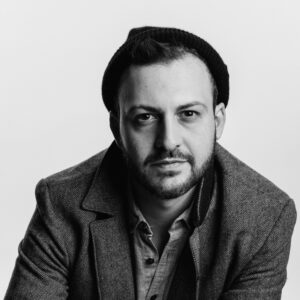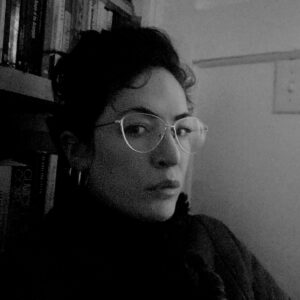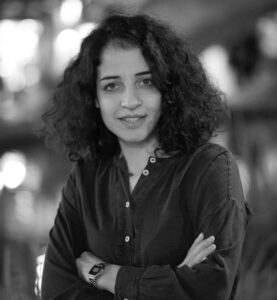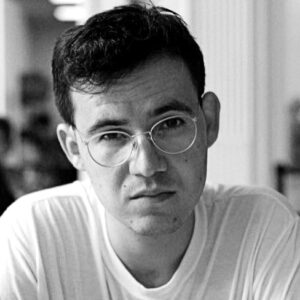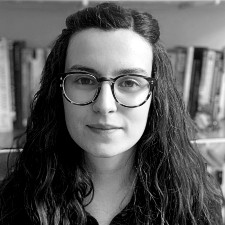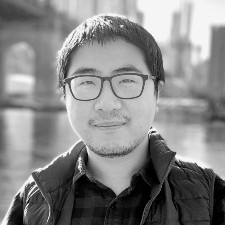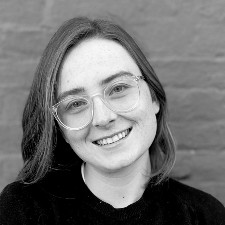Art Science Connect provides provides Dissertation Writing Fellowships and Research Fellowships for Graduate Center doctoral students whose research intersects the arts and sciences. The Research Fellowships provide funding for activities related to original research, such as field work, data collection, travel, and training. All fellows will have the opportunity to present their research in a public forum.
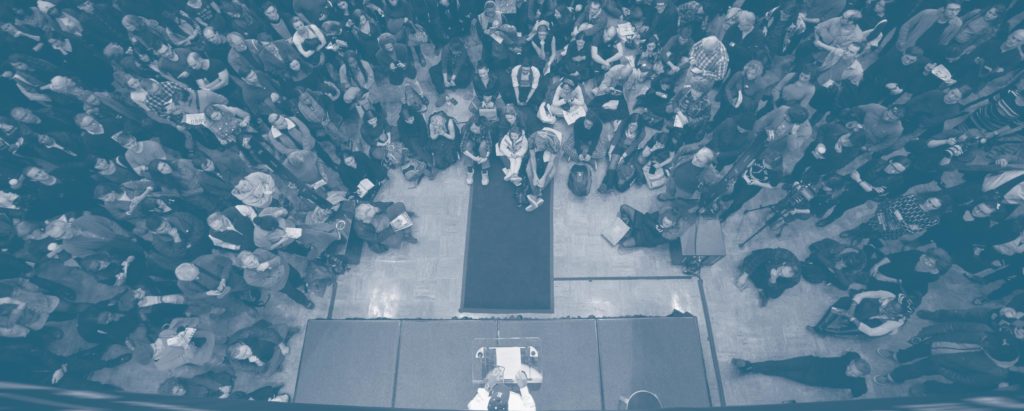
2023-24 Dissertation Fellow
Nicole Cote
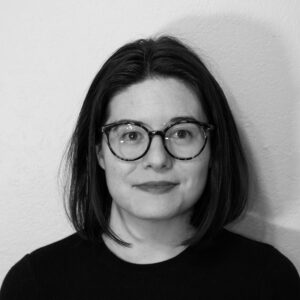 Nicole Cote’s dissertation centers on the production of public knowledge and understandings of disaster. She takes as her text and subject different narratives of environmental crisis underway in the American West. These examples serve as a lens for investigating the historical and contemporary entanglements of media, technology, and cultural work that shape how “natural” disasters are understood in the public sphere. Transdisciplinary in its production, her dissertation project employs written and digital methodologies.
Nicole Cote’s dissertation centers on the production of public knowledge and understandings of disaster. She takes as her text and subject different narratives of environmental crisis underway in the American West. These examples serve as a lens for investigating the historical and contemporary entanglements of media, technology, and cultural work that shape how “natural” disasters are understood in the public sphere. Transdisciplinary in its production, her dissertation project employs written and digital methodologies.
2023-24 Research Fellows
Nic Benacerraf
Nic Benacerraf’s dissertation project, The Theatre of Public Relations: Mise-en-Scène as Mass Persuasion, establishes a dramaturgy of PR as a form of covert, anti-political theatre. By combining the deconstructive methodologies of political theatre with the psychosocial research about human vulnerabilities that fuels PR’s manipulative disposition, the project searches for insights relevant to both fields of persuasive performance. Nic is a student in the Theatre & Performance program, and was previously a Mellon Public Humanities Fellow at the GC’s PublicsLab. He integrates his scholarship with his practice as a theatre director and scenographer, and is founding partner of Edge Effect Media Group.
Sydney Harvey
 Sydney Harvey is a doctoral student in the philosophy department. Her dissertation will consider the philosophical connection between conscious experience and cinema. This kind of work tends to focus on narrative structure and characters, and genre. Sydney focuses on the formal elements of the visual audio representation. As a filmmaker trained in film theory, she has developed strong skills in reading the artistic intention of lighting, composition, sound design, and camera movement. With her dissertation, she seeks to begin to alter the way viewers and philosophers watch cinema.
Sydney Harvey is a doctoral student in the philosophy department. Her dissertation will consider the philosophical connection between conscious experience and cinema. This kind of work tends to focus on narrative structure and characters, and genre. Sydney focuses on the formal elements of the visual audio representation. As a filmmaker trained in film theory, she has developed strong skills in reading the artistic intention of lighting, composition, sound design, and camera movement. With her dissertation, she seeks to begin to alter the way viewers and philosophers watch cinema.
Cathryn Jijon
Cathryn Jijon is a PhD student in art history specializing in modern and contemporary art of the Americas. Her research explores art and visual culture surrounding the Amazon rainforest in the 20th and 21st centuries, tracing the development of South American artistic movements alongside histories of resource extraction and anticolonial resistance in the region. Her project unpacks the ways that images are entangled in processes of resource extraction by alternatively imagining the Amazon as “El Dorado” or the “Interno Verde,” while foregrounding the ways that artists and activists build alternative, decolonized futures for the rainforest.
Sukie Kim
 Sukie Kim is a PhD student at the Graduate Center’s English program, where they use speculative fiction as an analytic framework to uncover the violent worldings of racial capitalism and settler colonialism, while bringing forward queer, more just world-making practices. Their dissertation examines how literary knowledge questions biocentrism and the overrepresentation of science as the only authoritative form of knowledge. Currently they are working on a dissertation chapter that looks at how post-War South Korea’s scientific imagination was informed by U.S. wars in the transpacific, and how such imagination is present and contested in contemporary speculative fiction.
Sukie Kim is a PhD student at the Graduate Center’s English program, where they use speculative fiction as an analytic framework to uncover the violent worldings of racial capitalism and settler colonialism, while bringing forward queer, more just world-making practices. Their dissertation examines how literary knowledge questions biocentrism and the overrepresentation of science as the only authoritative form of knowledge. Currently they are working on a dissertation chapter that looks at how post-War South Korea’s scientific imagination was informed by U.S. wars in the transpacific, and how such imagination is present and contested in contemporary speculative fiction.
2022-2023 Dissertation Fellows
Tobah Aukland-Peck
 Aukland-Peck’s dissertation, Mineral Landscapes: The Mine and British Modernism, examines the work of artists in mid-twentieth-century Britain who were drawn to the subject of mining, through which they explored pressing issues of labor, class, and environmental degradation through experiments with the formal qualities of modernism. Aukland-Peck argues that artworks related to the mine display the environmental shifts precipitated by long-term processes of extraction, evidence that the visual arts have been at the forefront of witnessing environmental changes and interpreting them into tangible forms.
Aukland-Peck’s dissertation, Mineral Landscapes: The Mine and British Modernism, examines the work of artists in mid-twentieth-century Britain who were drawn to the subject of mining, through which they explored pressing issues of labor, class, and environmental degradation through experiments with the formal qualities of modernism. Aukland-Peck argues that artworks related to the mine display the environmental shifts precipitated by long-term processes of extraction, evidence that the visual arts have been at the forefront of witnessing environmental changes and interpreting them into tangible forms.
Sedef Ozoguz
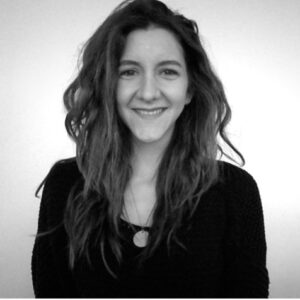 Sedef Ozoguz’s dissertation is a multidisciplinary exploration of the liberation of women in Turkey. She combines the principles of the arts and sciences, specifically of psychology and film to achieve aesthetic expressions grounded in data/truthful lived experiences in exploring the dreams of women in Turkey. She challenges the assumption that information is either aesthetic or scientific by showing that the aesthetic can get us to insights that are powerful. By translating research into an artistic expression, she hopes to make research accessible through her documentary, Wild Women of Anatolia and the Archives of Freedom Dreams, in pursuit of collective liberation, especially for the women of Turkey.
Sedef Ozoguz’s dissertation is a multidisciplinary exploration of the liberation of women in Turkey. She combines the principles of the arts and sciences, specifically of psychology and film to achieve aesthetic expressions grounded in data/truthful lived experiences in exploring the dreams of women in Turkey. She challenges the assumption that information is either aesthetic or scientific by showing that the aesthetic can get us to insights that are powerful. By translating research into an artistic expression, she hopes to make research accessible through her documentary, Wild Women of Anatolia and the Archives of Freedom Dreams, in pursuit of collective liberation, especially for the women of Turkey.
2022-2023 Research Fellows
Kirsten Gill
Kirsten Gill’s research focuses on the sociality of filmmaking practices, race, and the radical political imaginary. Uncovering suppressed media histories, her dissertation traces the development of psycho-cinematic practices alongside the discourses and manifestations of U.S. movements for Black liberation in the 1960s-1980s, arguing that filmmakers reconceived the cinematic apparatus in an attempt to mediate interracial relations. She situates her study within psychoanalytic and neuroscientific discourses, and shows how scientific metaphors for the moving image as “flickering brain” and extension of the central nervous system implicated the anti-racist retraining of the movie-goer’s brain and the body.
Stephen Spencer
 Stephen Spencer’s research focuses on the function of timbre and orchestration in music. His dissertation develops a method for the analysis and visualization of instrumental sound in modernist and contemporary music, merging conventional analytical systems with current research in auditory perception and computational acoustics. By coordinating symbolic data (from written sheet music) with perceptual and acoustic data (from recorded performances), Stephen’s research enables a timbre-based reevaluation of musical works that have been underserved by music theory’s pitch-based methods.
Stephen Spencer’s research focuses on the function of timbre and orchestration in music. His dissertation develops a method for the analysis and visualization of instrumental sound in modernist and contemporary music, merging conventional analytical systems with current research in auditory perception and computational acoustics. By coordinating symbolic data (from written sheet music) with perceptual and acoustic data (from recorded performances), Stephen’s research enables a timbre-based reevaluation of musical works that have been underserved by music theory’s pitch-based methods.
Tamara Maatouk
Tamara Maatouk’s research project addresses the photograph as both art and science to explore uncharted territories in histories of medicine and the body in nineteenth- and early twentieth-century Egypt. It seeks to examine the criteria governing the selection of photographs in medical publications, the functions they performed or were intended to serve, and, more importantly, the stories they can and may tell us that written texts and official documents cannot or do not. In so doing, this research intends to show the similarities and continuities that existed in the colonial and local use of these photographs, but also the clear distinctions between them, specifically, the racialization of the disease on the part of the colonial medical practitioners—linking a particular disease to the face and body of the Egyptian peasant.
Kyueun Kim
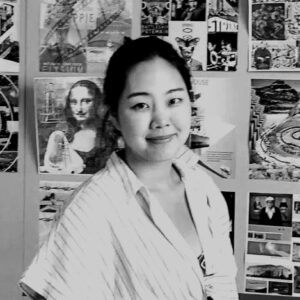 Kyueun Kim’s project examines how physical and virtual realities collide and interweave in site-specific and participatory virtual reality (VR) performances. In addition to exploring how artists use VR in their performances, the project explores the possibilities of VR as an experiential medium for embodied and situated knowledge production. For example, do interviews with VR artists in VR create new epistemologies that are expanded in the sense that VR claims to expand human senses and experience? What kinds of different experiences might be generated in virtual environments and what are the implications of this for my research? The research findings will contribute to the larger framework of her dissertation, which moves beyond the racial stereotypes of Techno-Orientalism to demonstrate the porous boundaries and interconnectedness between humans and nonhumans (including technology, media, ghosts, and ancestors) in East Asia.
Kyueun Kim’s project examines how physical and virtual realities collide and interweave in site-specific and participatory virtual reality (VR) performances. In addition to exploring how artists use VR in their performances, the project explores the possibilities of VR as an experiential medium for embodied and situated knowledge production. For example, do interviews with VR artists in VR create new epistemologies that are expanded in the sense that VR claims to expand human senses and experience? What kinds of different experiences might be generated in virtual environments and what are the implications of this for my research? The research findings will contribute to the larger framework of her dissertation, which moves beyond the racial stereotypes of Techno-Orientalism to demonstrate the porous boundaries and interconnectedness between humans and nonhumans (including technology, media, ghosts, and ancestors) in East Asia.2021-2022 Dissertation Fellows
Shima Houshyar
Shima Houshyar’s research focuses on the material and aesthetic politics of engineering and infrastructure as they shaped the Iranian nation-state during the Cold War. Addressing engineering as technical and aesthetic practice, this research examines the ways that infrastructural development produced novel conceptions of ecology and landscape, and evoked contradictory political imaginaries, affects, and visions of Iranian national modernity.
Joseph Henry
Joseph Henry’s research focuses on the artistic movement known as German Expressionism, in particular the artists of “Die Brücke” (The Bridge). Reading their work through discourses and practices such as occupational science, manufacturing, and physical anthropology, his dissertation argues that Die Brücke mediated a new German subject structured by both affective interiority and capitalist rationalization at a time of prewar Germany’s rapid industrialization. Accordingly, Henry looks to situate Expressionism as a prefiguration of machine aesthetics within broader histories of modern art.
2021-2022 Research Fellows
Jessica Fletcher
Jessica Fletcher’s dissertation, “A Municipal Modernity” traces the architectural history of the district health centers in New York City that women reformers and their allies sponsored and built from 1913 until 1950. It reveals that women’s philanthropic adaptive re-use, foundational to the architecture of the public health care in New York, led to a program of municipal district health centers during the New Deal.
Shao Liu
Shao Liu’s research focuses on developing novel features and mature model structure for art movement classification of portrait paintings and emotion analysis of facial cues in paintings. By using computer vision and deep learning techniques, his work achieved significant results in identifying 6 art movement classes. Another contribution of this work is a new portrait database: Portrait-face for art movement classification and facial emotion recognition, which could benefit future portrait painting research.
Hadley Newton
Hadley Newton’s research is concerned with the confluence of concepts and methodologies of perceptual psychology with artistic practices and discourses in the United States in the 1960s and beyond. By examining artists’ engagement with the theories of dynamic, embodied perception advanced by James J. Gibson, her work seeks to illuminate a broader cultural imperative to reappraise the epistemological value of lived experience.
Anna Orton-Hatzis
Anna Orton-Hatzis’s dissertation investigates Rosa Bonheur’s sustained interest in zoology, taxidermy, veterinary science and animal welfare. Recasting typical narratives of the artist through interdisciplinary methodological approaches such as ecocriticism and animal studies, and borrowing from the history of science, philosophy, anthropology and literature, Orton-Hatzis’s archival research reveals the painter’s integral, yet overlooked connection to the sciences and debates on animal welfare.
Student Fellows of 2020-2021
Cory Tamler
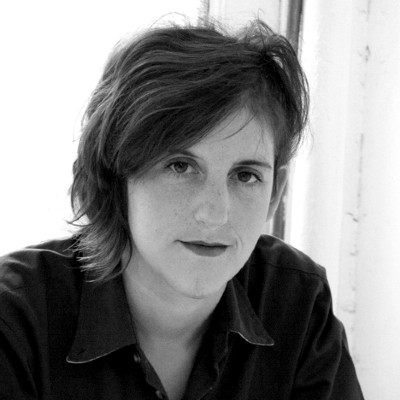 Cory Tamler’s dissertation project is concerned with the ways arts and sciences emerge from, and dynamically impact on, the same material conditions that shape the thoughts that human beings are capable of thinking. Her research draws together histories of modern physics and concurrent theatrical and performance movements from the twentieth century to our own times.
Cory Tamler’s dissertation project is concerned with the ways arts and sciences emerge from, and dynamically impact on, the same material conditions that shape the thoughts that human beings are capable of thinking. Her research draws together histories of modern physics and concurrent theatrical and performance movements from the twentieth century to our own times.
Brad Fox
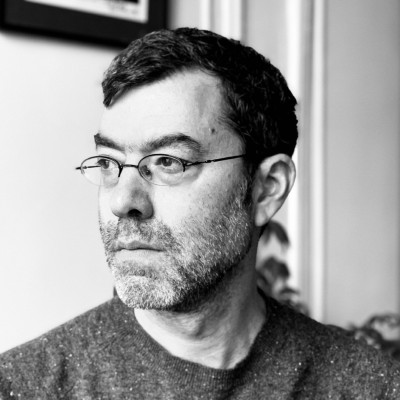 Brad Fox’s research focusses on the bathysphere logbooks, the first eyewitness account of the deep ocean, dispatched from a steel ball suspended a half mile below the ocean’s surface. Based on original archival work and field research on the Atlantic island of Nonsuch, Brad establishes the bathysphere logbooks as objects of major historical and scientific importance, unique records of secular mysticism, and foundational materials for today’s ecological and oceanic imagination.
Brad Fox’s research focusses on the bathysphere logbooks, the first eyewitness account of the deep ocean, dispatched from a steel ball suspended a half mile below the ocean’s surface. Based on original archival work and field research on the Atlantic island of Nonsuch, Brad establishes the bathysphere logbooks as objects of major historical and scientific importance, unique records of secular mysticism, and foundational materials for today’s ecological and oceanic imagination.
Rachel Spaulding Carty
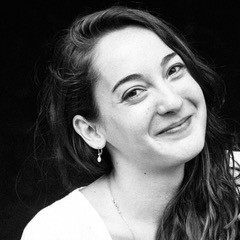 Rachel Spaulding Carty’s research revolves around the close-range images of the Moon captured by NASA’s unmanned spacecraft during the 1960s, and how artists engaged with this body of scientific imagery. Her work examines the visual, evidential, and ideological roles played by unmanned spacecraft photography, and studies how the circulation of such images altered conceptions of cosmic vision in the years before the Apollo moon landing.
Rachel Spaulding Carty’s research revolves around the close-range images of the Moon captured by NASA’s unmanned spacecraft during the 1960s, and how artists engaged with this body of scientific imagery. Her work examines the visual, evidential, and ideological roles played by unmanned spacecraft photography, and studies how the circulation of such images altered conceptions of cosmic vision in the years before the Apollo moon landing.
Aubrey Knox
 Aubrey Knox’s research focuses on the Grand Palais’ transformation into a military hospital during World War I, addressing the intersection of art and medicine through three primary categories: the architecture of hospitals and exhibition spaces, the history of art and its connection to the scientific understanding of the human body, and the history of photography as an emerging diagnostic and visual language.
Aubrey Knox’s research focuses on the Grand Palais’ transformation into a military hospital during World War I, addressing the intersection of art and medicine through three primary categories: the architecture of hospitals and exhibition spaces, the history of art and its connection to the scientific understanding of the human body, and the history of photography as an emerging diagnostic and visual language.
Alfredo Vidal-Ceballos
 Alfredo Vidal-Ceballos’s research focuses on the role that material properties, such as viscosity and surface tension, play in regulating biomolecular liquids in the nervous system. By combining cutting-edge microscopy techniques, he will exploit his findings to generate captivating “molecular art” on the micron scale in order to visually communicate his research.
Alfredo Vidal-Ceballos’s research focuses on the role that material properties, such as viscosity and surface tension, play in regulating biomolecular liquids in the nervous system. By combining cutting-edge microscopy techniques, he will exploit his findings to generate captivating “molecular art” on the micron scale in order to visually communicate his research.

